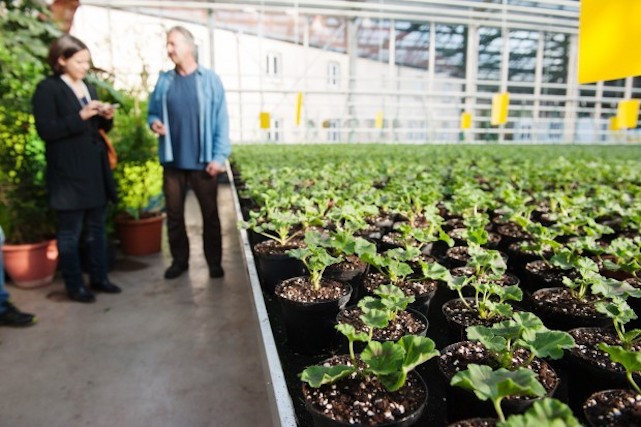Marc Theis oversees the ornamental plant nursery and says the plants are almost “like my children”. As he describes it, he watches the plants pass through three phases: from a more humid nursery, to the 18°C “crèche”, to “primary school”, where plants get used to a cooler climate (13°C).
This gradual transition ensures plants will be hardy enough to face the outdoors, where they will be planted in parks, playgrounds and other public spaces across the Luxembourg capital. The spring planting, which occurred at the end of March, is already visible in places such as the garden near the Boulevard Roosevelt, below the Gëlle Fra, which was lined with yellow and orange pansies at the time of writing.
150,000 plants annually
It’s a massive operation: every year, around 150,000 plants are cultivated by the Services des Parcs at the 2,780 m2 greenhouse based in Reckenthal.
And it isn’t just petunias or geraniums either: Theis also helps tend other plants on the premises, such as a papaya tree and pitcher plant. The greenhouse as it stands today was only fully operational as of November 2015 (partially by 2014); the former site was demolished completely in 2009 to make way for rebuilding the current site.
Marc Theis (right), shown here with Luc Lacour (left), points out the automated window system. Picture: Lala La Photo
As Theis points out, much is now automated. For example, computers help regulate the flow of water which runs from a tank to wet the mats beneath the plants in the nursery. If there is an overflow, the water flows back so it isn’t wasted. “Last year, we actually didn’t have enough water in Luxembourg!” Theis says, laughing. “But normally, there’s plenty.”
Windows can also be programmed to open or close as needed, meaning plants that require more humidity can be effectively grown, even without being in their ideal natural climates. Some trees and plants go “on loan” to the various municipal buildings, but are brought back to the facilities for upkeep.
It sounds like a lot of work, but Theis works closely with the staff, as well as several apprentices, to make organisation runs smoothly: an apprenticeship includes not just theoretical knowledge, including mastering nomenclature, but also practical work such as planting and maintenance.
Bringing a smile to the elderly
Luc Lacour is responsible for the organisation of the entire greenhouse, which includes not just the ornamental plants area, but also the floristic and decoration section and the maintenance of all flower boxes within Luxembourg City.
Staff at the greenhouse create their own arrangements including this one, a test in preparation of the Luxembourg national holiday. Picture: Lala La Photo
Lacour also works with other staff to prepare unique floral arrangements, whether they are for weddings or special visits, to name just a few. On the greenhouse floor, for example, is a pot with several dozens of flowers, including roses and Gerber daisies--“an experiment we did for the Luxembourg national holiday,” he explains.
The greenhouse receives shipments of fresh flowers from the Netherlands twice a week, which are used in the commune and other municipal offices and buildings. “We also prepare floral arrangements for [Luxembourg City] residents age 90 and over for their birthdays,” he says. “This year, we prepared around 900.” He adds that this number has increased over the years he has been there--perhaps a positive indicator for Luxembourg’s elderly population.


